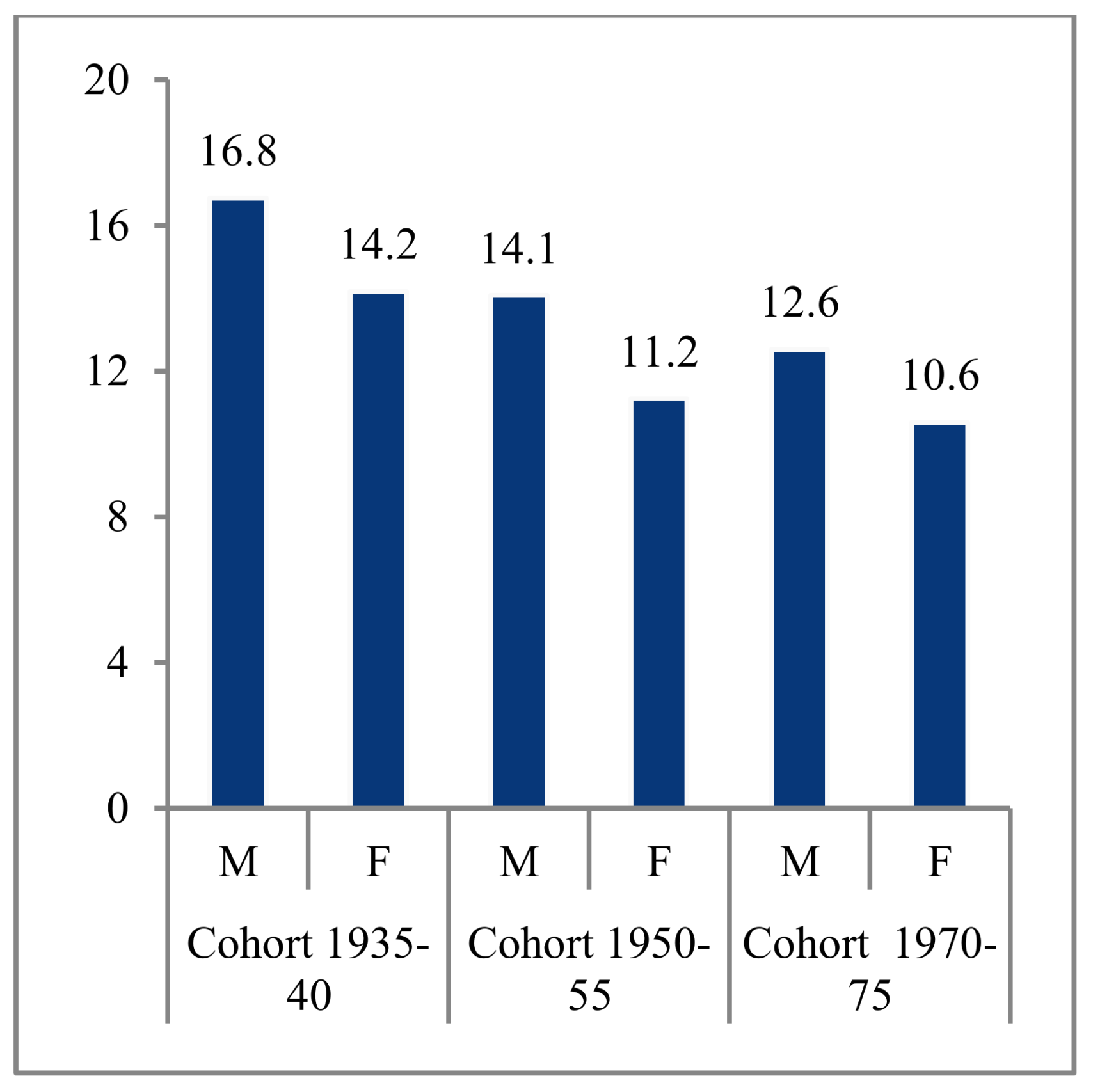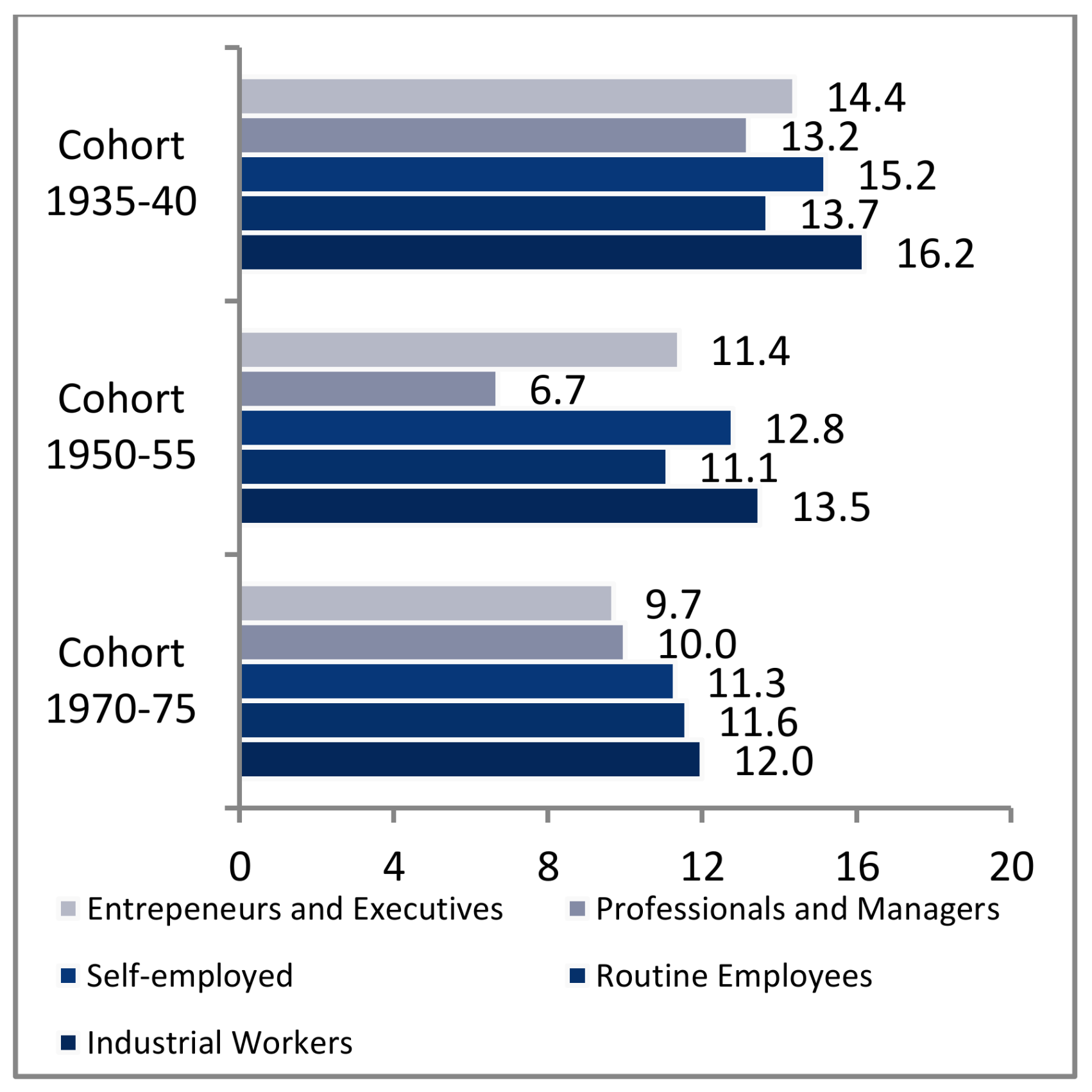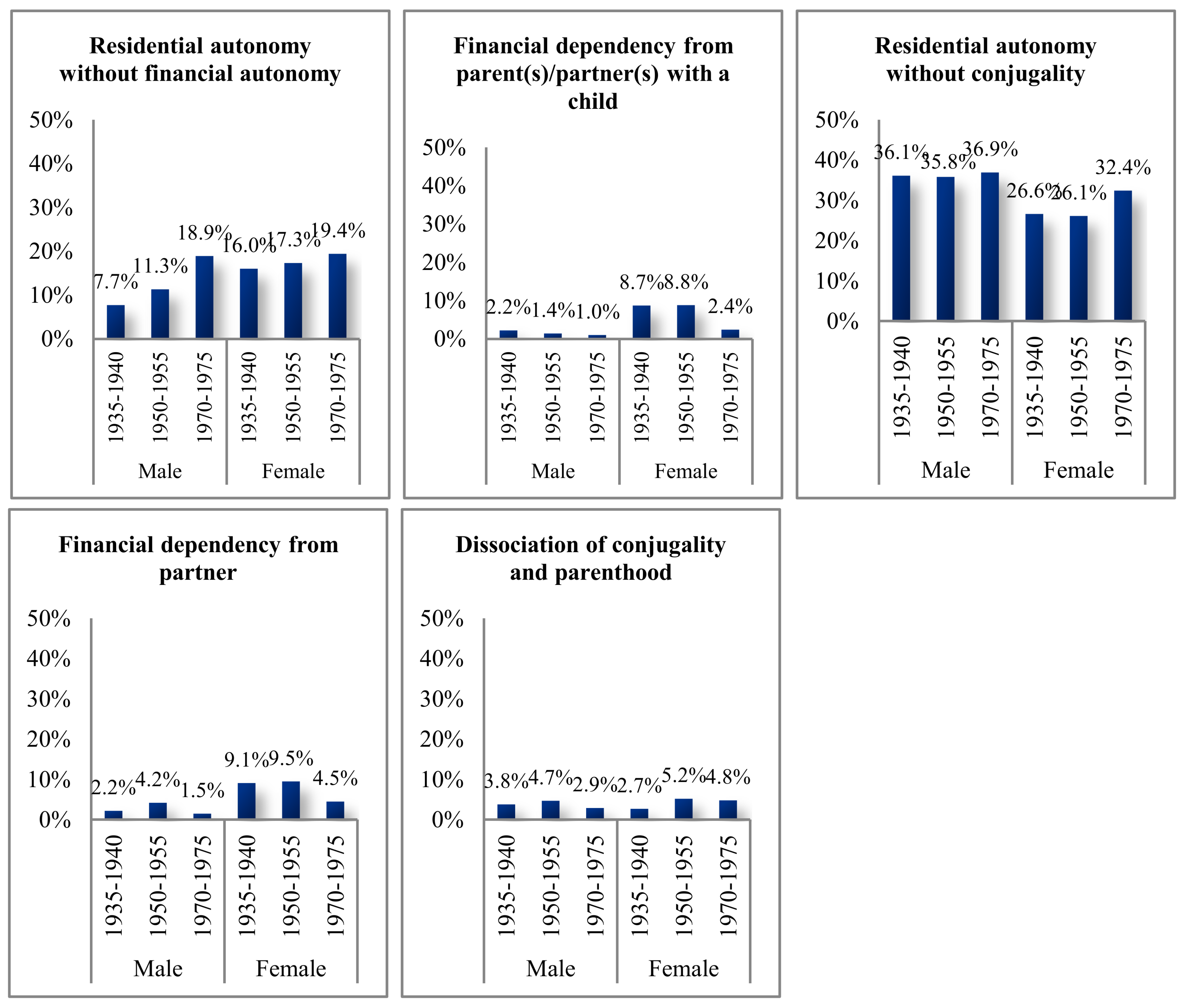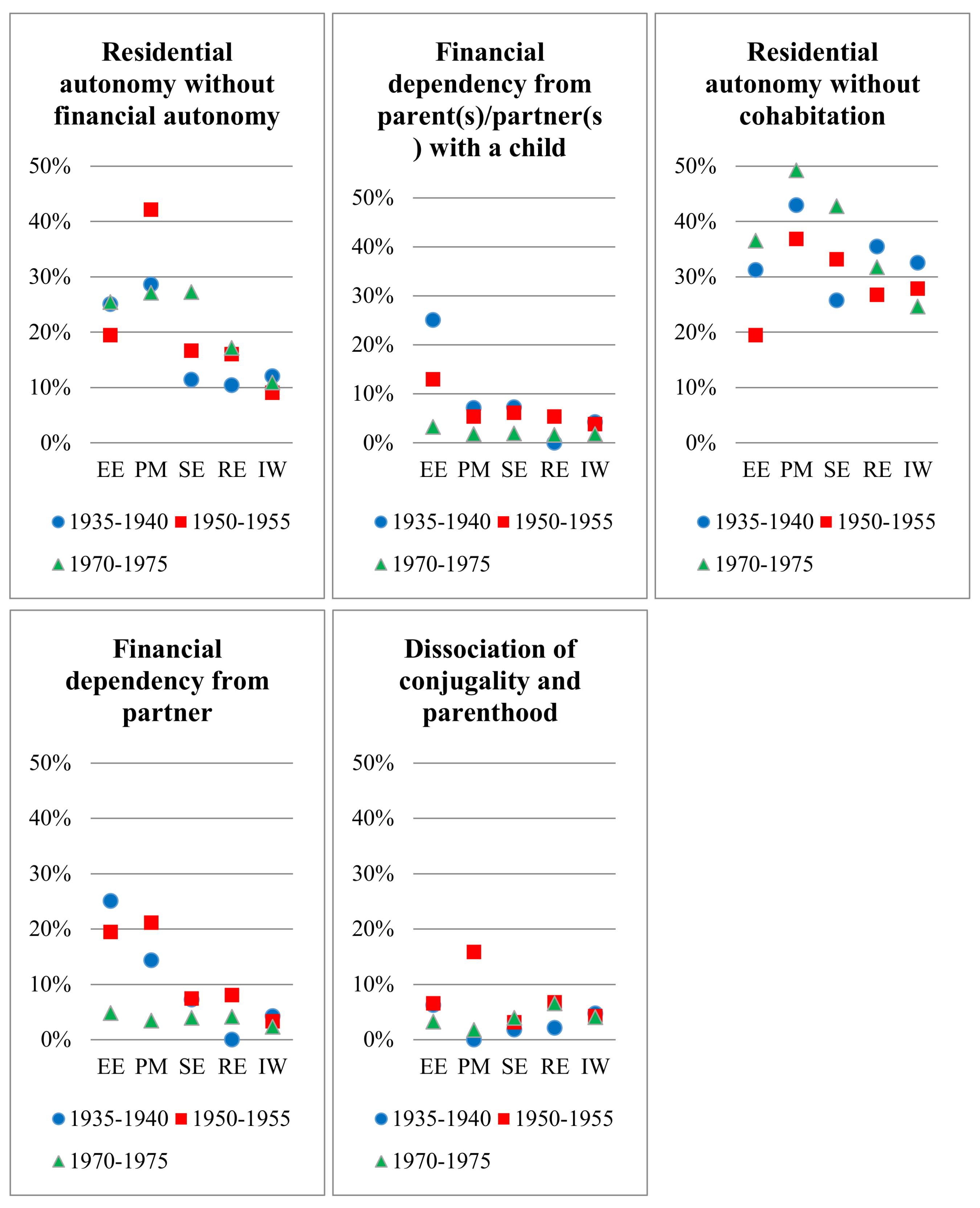Transitions to Adulthood and Generational Change in Portugal
Abstract
:1. Introduction
1.1. Towards a Critique Reading of Calendars, Norms and Social Roles
1.2. Recent Trends and the Portuguese Case
2. Materials and Methods
Data
Key Dimensions and Concepts
3. Results
3.1. Transition Calendars: Converging and Diverging Trends
3.2. The Duration of Transitional Calendars
3.3. Prevalence of Transitions: from Anticipation to Postponement
3.4. Changes to the “Normative” Transitional Order
4. Discussion
Limitations
Acknowledgments
Conflicts of Interest
References
- Billari, F.C.; Liefbroer, A.C. Towards a new pattern of transition to adulthood? Adv. Life Course Res. 2010, 15, 59–75. [Google Scholar] [CrossRef]
- Buchmann, M.C.; Kriesi, I. Transition to Adulthood in Europe. Annu. Rev. Sociol. 2011, 37, 481–503. [Google Scholar] [CrossRef]
- Hogan, D.P. The variable order of events in the life course. Am. Sociol. Rev. 1978, 43, 573–586. [Google Scholar] [CrossRef]
- Hogan, D.P.; Astone, N.M. The transition to adulthood. Annu. Rev. Sociol. 1986, 12, 109–130. [Google Scholar] [CrossRef]
- Modell, J. Normative aspects of American marriage timing since World War II. J. Fam. Hist. 1980, 5, 210–234. [Google Scholar] [CrossRef]
- Rindfuss, R.R.; Swicegood, C.G.; Rosenfeld, R.A. Disorder in the life course: How common and does it matter? Am. Sociol. Rev. 1987, 52, 785–801. [Google Scholar] [CrossRef]
- Shanahan, M.J. Pathways to adulthood in changing societies: Variability and mechanisms in life course perspective. Annu. Rev. Sociol. 2000, 26, 667–692. [Google Scholar] [CrossRef]
- Marini, M.M. Age and sequencing norms in the transition to adulthood. Soc. Forces 1984, 63, 229–244. [Google Scholar] [CrossRef]
- Pais, J.M. Cursos de vida, padronizações e disritmias. In Tempos e Transições de Vida: Portugal ao Espelho da Europa; Pais, J.M., Ferreira, V.S., Eds.; ICS: Lisboa, Portugal, 2010; pp. 19–35. [Google Scholar]
- Macmillan, R. The structure of the life course: Classic issues and current controversies. Adv. Life Course Res. 2005, 9, 3–24. [Google Scholar] [CrossRef]
- Settersten, R.A., Jr.; Mayer, K.U. The measurement of age, age structuring, and the life course. Annu. Rev. Sociol. 1997, 23, 233–261. [Google Scholar] [CrossRef]
- Marini, M.M. The order of events in the transition to adulthood. Sociol. Educ. 1984, 57, 63–84. [Google Scholar] [CrossRef]
- Nico, M. Transição Biográfica Inacabada. Transições Para a Vida Adulta em Portugal e na Europa na Perspectiva do Curso do Vida; ISCTE—Instituto Universitário de Lisboa: Lisboa, Portugal, 2011. [Google Scholar]
- Elder, G.H.; Johnson, M.K.; Crosnoe, R. The emergence and development of life course theory. In Handbook of the Life Course; Mortimer, J.T., Shanahan, M.J., Eds.; Kluwer Academic Publications: New York, NY, USA, 2002; pp. 3–19. [Google Scholar]
- Mayer, K.U. Whose lives? How history, societies, and institutions define and shape life courses. Res. Hum. Dev. 2004, 1, 161–187. [Google Scholar] [CrossRef]
- Mortimer, J.T.; Oesterle, S.; Krüger, H. Age norms, institutional structures, and the timing of markers of transition to adulthood. Adv. Life Course Res. 2005, 9, 175–203. [Google Scholar] [CrossRef]
- George, L.K. Sociological perspectives on life transitions. Annu. Rev. Sociol. 1993, 19, 353–373. [Google Scholar] [CrossRef]
- Furstenberg, F.F. Reflections on the future of the life course. In Handbook of the Life Course; Mortimer, J.T., Shanahan, M.J., Eds.; Kluwer Academic Publications: New York, NY, USA, 2002; pp. 661–670. [Google Scholar]
- Kohli, M. The institutionalization of the life course: Looking back to look ahead. Res. Hum. Dev. 2007, 4, 253–271. [Google Scholar] [CrossRef]
- Goodwin, J.; O’Connor, H. A critical reassessment of the ‘complexity’ orthodoxy: Lessons from existing data and youth ‘legacy’ studies. In A Critical Youth Studies for the 21st Century; Kelly, P., Kamp, A., Eds.; Brill: Leiden, The Netherlands; Boston, MA, USA, 2015; pp. 38–52. [Google Scholar]
- Goodwin, J.; O’Connor, H. Exploring complex transitions: Looking back at the ‘golden age’ of from school to work. Sociology 2005, 39, 201–220. [Google Scholar] [CrossRef]
- Kohli, M. The world we forgot: A historical review of the life course. In The Life Course Reader: Individuals and Societies Across Time; Heinz, W.R., Huinink, J., Weymann, A., Eds.; Campus-Verlag: Frankfurt, Germany, 2009. [Google Scholar]
- Aboim, S.; Vasconcelos, P. From political to social generations: A critical reappraisal of Mannheim’s classical approach. Eur. J. Soc. Theory 2014, 17, 165–183. [Google Scholar] [CrossRef]
- Modell, J.; Furstenberg, F.F.; Hershberg, T. Social change and transitions to adulthood in historical perspective. J. Fam. Hist. 1976, 1, 7–32. [Google Scholar] [CrossRef]
- Biggart, A.; Walther, A. Coping with yo-yo-transitions: Young adults’ struggle for support, between family and state in comparative perspective. In A New Youth? Young People, Generations and Family Life; Leccardi, C., Ruspini, E., Eds.; Ashgate: Aldershot, UK, 2006. [Google Scholar]
- Gauthier, A.H. Becoming a young adult: An international perspective on the transitions to adulthood. Eur. J. Popul. Rev. Eur. Démogr. 2007, 23, 217–223. [Google Scholar] [CrossRef]
- Settersten, R.A., Jr. Passages to adulthood: Linking demographic change and human development. J. Popul. Rev. Eur. Démogr. 2007, 23, 251–272. [Google Scholar] [CrossRef]
- Iacovou, M. Regional differences in the transition to adulthood. Ann. Am. Acad. Political Soc. Sci. 2002, 580, 40–69. [Google Scholar] [CrossRef]
- Billari, F.C. Becoming an adult in Europe: A macro(/micro)-demographic perspective. Demogr. Res. 2004, S3, 15–44. [Google Scholar] [CrossRef]
- Torres, A.; Mendes, R.; Lapa, T. Families in Europe. Port. J. Soc. Sci. 2008, 7, 49–84. [Google Scholar] [CrossRef]
- Vogel, J. European welfare regimes and the transition to adulthood: A comparative and longitudinal perspective. Soc. Indic. Res. 2002, 59, 275–299. [Google Scholar] [CrossRef]
- Brzinsky-Fay, C. Lost in transition? Labour market entry sequences of school leavers in Europe. Eur. Sociol. Rev. 2007, 23, 409–422. [Google Scholar] [CrossRef]
- Chauvel, L.; Schröder, M. Generational inequalities and welfare regimes. Soc. Forces 2014, 92, 1259–1283. [Google Scholar] [CrossRef]
- Scherer, S. Patterns of labour market entry—Long wait or career instability? An empirical comparison of Italy, great Britain and west Germany. Eur. Sociol. Rev. 2005, 21, 427–440. [Google Scholar] [CrossRef]
- Korpi, T.; de Graaf, P.; Hendrickx, J.; Layte, R. Vocational training and career employment precariousness in great Britain, the Netherlands and Sweden. Acta Sociol. 2003, 46, 17–30. [Google Scholar] [CrossRef]
- Ferreira, V.S.; Nunes, C. Transições para a vida adulta. In Tempos e Transições de vida: Portugal ao Espelho da Europa; Pais, J.M., Ferreira, V.S., Eds.; ICS: Lisboa, Portugal, 2010; pp. 39–67. [Google Scholar]
- Guerreiro, M.d.D.; Abrantes, P. Transições Incertas. Os Jovens Perante o Trabalho e a Família; CITE: Lisboa, Portugal, 2004. [Google Scholar]
- Arts, W.I.L.; Gelissen, J. Three worlds of welfare capitalism or more? A state-of-the-art report. J. Eur. Soc. Policy 2002, 12, 137–158. [Google Scholar] [CrossRef]
- Aassve, A.; Billari, F.C.; Mazzuco, S.; Ongaro, F. Leaving home: A comparative analysis of ECHP data. J. Eur. Soc. Policy 2002, 12, 259–275. [Google Scholar] [CrossRef]
- Sobotka, T.; Toulemon, L. Overview chapter 4: Changing family and partnership behaviour: Common trends and persistent diversity across Europe. Demogr. Res. 2008, S7, 85–138. [Google Scholar] [CrossRef]
- Vasconcelos, P. Famílias complexas: Tendências de evolução. Sociol. Probl. Prát. 2003, 43, 83–96. [Google Scholar]
- Aboim, S. Cronologias da Vida Privada. In Tempos e Transições de Vida: Portugal ao Espelho da Europa; Pais, J.M., Ferreira, V.S., Eds.; ICS: Lisboa, Portugal, 2010; pp. 107–148. [Google Scholar]
- Elchardus, M.; Smits, W. The persistence of the standardized life cycle. Time Soc. 2006, 15, 303–326. [Google Scholar] [CrossRef]
- Guerreiro, M.d.D.; Abrantes, P. Como tornar-se adulto: Processos de transição na modernidade avançada. Rev. Brasil. Ciênc. Soc. 2005, 20, 157–175. [Google Scholar] [CrossRef]
- Delgado, A.; Wall, K.E. Famílias Nos Censos 2011: Diversidade e Mudança; Instituto Nacional de Estatística/Imprensa de Ciências Sociais: Lisboa, Portugal, 2014. [Google Scholar]
- Nico, M. Variability in the transitions to adulthood in Europe: A critical approach to de-standardization of the life course. J. Youth Stud. 2013, 17, 166–182. [Google Scholar] [CrossRef]
- Alwin, D.F.; McCammon, R.J. Generations, cohorts, and social change. In Handbook of the Life Course; Kluwer Academic Publications: New York, NY, USA, 2002; pp. 23–49. [Google Scholar]
- Brückner, H.; Mayer, K.U. De-standardization of the life course: What it might mean? And if it means anything, whether it actually took place? Adv. Life Course Res. 2005, 9, 27–53. [Google Scholar] [CrossRef]
- Pollock, G. Holistic trajectories: A study of combined employment, housing and family careers by using multiple-sequence analysis. J. R. Stat. Soc. Ser. A 2007, 170, 167–183. [Google Scholar] [CrossRef]
- Abbott, A.; Tsay, A. Sequence analysis and optimal matching methods in sociology: Review and prospect. Sociol. Methods Res. 2000, 29, 3–33. [Google Scholar] [CrossRef]
- Toulemon, L. Transition to adulthood in Europe: Is there convergence between countries and between men and women? In Research Note for the European Commission; INED: Paris, France, 2010. [Google Scholar]
- Rodrigues, M.C.F. Portugal e a Organização Internacional do Trabalho (1933–1974); Universidade de Coimbra: Coimbra, Portugal, 2012. [Google Scholar]
- Costa, A.F.; Mauritti, R.; Martins, S.d.C.; Machado, F.L.; Almeida, J.F.d. Classes sociais na Europa. Sociol. Probl. Prát. 2000, 34, 9–43. [Google Scholar]
- Almeida, J.F.d.; Machado, F.L.; Costa, A.F.d. Classes sociais e valores em contexto europeu. In Contextos e Atitudes Sociais na Europa; Vala, J., Torres, A., Eds.; Imprensa de Ciências Sociais: Lisboa, Portugal, 2007; pp. 69–96. [Google Scholar]
- Billari, F.C. The analysis of early life courses: Complex descriptions of the transition to adulthood. J. Popul. Res. 2001, 18, 119–142. [Google Scholar] [CrossRef]
- Mónica, M.F. Educação e Classes Sociais; Editorial Presença e Gabinete de Investigação Social: Lisboa, Portugal, 1978. [Google Scholar]
- Nóvoa, A. Política educativa do Estado Novo. In Dicionário de História de Portugal; Barreto, A., Mónica, M.F., Eds.; Figueirinhas: Porto, Portugal, 1996. [Google Scholar]
- Casaca, S.F. A (des)igualdade de género e a precarização do emprego. In A Igualdade de Mulheres e Homens no Trabalho e no Emprego em Portugal: Políticas e Circunstâncias; Ferreira, V., Ed.; CITE: Lisboa, Portugal, 2010. [Google Scholar]
- Ramos, V. Informality, stability and precarity: A sequential analysis of occupational trajectories over the last few decades. Sociol. Probl. Prát. 2017, 84, 43–62. [Google Scholar]
- Mauritti, R. Viver Só: Mudança Social e Estilos de Vida; ISCTE—Instituto Universitário de Lisboa: Lisboa, Portugal, 2009. [Google Scholar]
- Guerreiro, M.d.D.; Caetano, A. Pessoas sós em Portugal: Evolução e perfis sociais. In Famílias Nos Censos 2011: Diversidade e Mudança; Delgado, A., Wall, K., Eds.; Instituto Nacional de Estatística/Imprensa de Ciências Sociais: Lisboa, Portugal, 2014; pp. 125–153. [Google Scholar]
- Martins, S.d.C.; Mauritti, R.; Costa, A.F.d. Condições Socioeconómicas dos Estudantes do Ensino Superior em Portugal; DGES/MCTES: Lisboa, Portugal, 2005.
- Cunha, V. Trajetórias não reprodutivas em três gerações de portugueses: incidência, circunstâncias, oportunidade. In VII Congresso Português de Sociologia: Sociedade, Crise e Reconfigurações; Associação Portuguesa de Sociologia: Lisbon, Portugal, 2012. [Google Scholar]
- Cunha, V. Quatro décadas de declínio da fecundidade em Portugal. In Inquérito à Fecundidade 2013; INE/FFMS: Lisboa, Portugal, 2014; pp. 19–28. [Google Scholar]
- Rosas, F. O salazarismo e o homem novo: Ensaio sobre o Estado Novo e a questão do totalitarismo. Anál. Soc. 2001, XXXV, 1031–1054. [Google Scholar]
- Furlong, A.; Cartmel, F. Young People and Social Change: New Perspectives, 2nd ed.; Open University Press: Buckingham, UK, 2007. [Google Scholar]
- Elzinga, C.H.; Liefbroer, A.C. De-standardization of family-life trajectories of young adults: A cross-national comparison using sequence analysis. Eur. J. Popul. Rev. Eur. Démogr. 2007, 23, 225–250. [Google Scholar] [CrossRef] [Green Version]
- Levy, R.; Widmer, E.D. Gendered Life Courses between Standardization and Individualization: A European Approach Applied to Switzerland; LIT Verlag: Zürich, Switzerland; Berlin, Germany, 2013. [Google Scholar]
| 1 | Translated from Portuguese by the author. |
| 2 | Fieldwork was completed by a subcontracted field agency (GFK/Metris). |
| 3 | Since each of five events may or may not have occurred, the number of potential combinations is ((5*2)!/((5*2 − 5)!*5) = 252. |
| 4 | Only in 1971 work for those under 14 years was outlawed [52]. In 1991, in the face of a worrying persistence of child labor, the minimum age to work was raised to 15 years of age and further extended to 16 in 1997 (Diário da República, I Série-A, n.° 238/91, Decreto-Lei n.° 396/91). Only in 1998, Portugal adhered to the ILO Convention (138), which establishes the minimum age for admission to general employment at 16 years of age, and 18 years for those in public functions (Diário da República, I Série-A, n.° 66/98). |
| 5 | As a marker for leaving school, we considered the proportion of individuals that completed secondary education. |
| 6 | For the sake of parsimony, we only consider the 30-year-old threshold, which is the most commonly used in research on transitions to adulthood. |




| Index | Meaning |
|---|---|
| Left parental home before starting work | Residential autonomy without financial autonomy |
| Became a parent before starting work | Financial dependency from parent(s)/partner(s) with a child |
| Left parental home before starting a cohabiting relationship | Residential autonomy without cohabitation |
| Started a cohabiting relationship before starting work | Financial dependency from partner |
| Became a parent before starting a cohabiting relationship | Dissociation of conjugality and parenthood |
| Markers | Cohort | 25% | Median | 75% | Mean | Standard Deviation | Inter Quartile Range | Mean S.E. |
|---|---|---|---|---|---|---|---|---|
| Finished/left school | 1935–1940 | 11.0 | 11.0 | 13.0 | 13.2 | 5.4 | 2.0 | 0.28 |
| 1950–1955 | 11.0 | 12.0 | 16.0 | 14.1 | 4.9 | 5.0 | 0.22 | |
| 1970–1975 | 14.0 | 18.0 | 24.0 | 19.8 | 7.5 | 10.0 | 0.33 | |
| Started working * | 1935–1940 | 8.0 | 12.0 | 14.0 | 12.5 | 5.6 | 6.0 | 0.27 |
| 1950–1955 | 11.0 | 13.0 | 17.0 | 14.7 | 5.6 | 6.0 | 0.25 | |
| 1970–1975 | 14.0 | 18.0 | 21.0 | 17.7 | 4.6 | 7.0 | 0.20 | |
| Left parental home | 1935–1940 | 18.0 | 22.0 | 25.0 | 22.2 | 9.5 | 7.0 | 0.45 |
| 1950–1955 | 18.0 | 21.0 | 24.0 | 21.8 | 7.8 | 6.0 | 0.35 | |
| 1970–1975 | 19.0 | 22.0 | 26.0 | 21.8 | 6.2 | 7.0 | 0.28 | |
| Started cohabitation | 1935–1940 | 21.0 | 23.0 | 26.0 | 23.6 | 4.4 | 5.0 | 0.21 |
| 1950–1955 | 20.0 | 22.0 | 25.0 | 22.7 | 4.1 | 5.0 | 0.18 | |
| 1970–1975 | 21.0 | 24.0 | 27.0 | 24.0 | 4.2 | 6.0 | 0.20 | |
| Became a parent | 1935–1940 | 22.0 | 25.0 | 28.0 | 25.5 | 4.7 | 6.0 | 0.23 |
| 1950–1955 | 22.0 | 24.0 | 27.0 | 24.7 | 4.5 | 5.0 | 0.21 | |
| 1970–1975 | 23.0 | 26.0 | 29.0 | 26.2 | 4.5 | 6.0 | 0.22 |
| Cohort 1935–1940 | Cohort 1950–1955 | Cohort 1970–1975 | |||||||
|---|---|---|---|---|---|---|---|---|---|
| Total | M | F | Total | M | F | Total | M | F | |
| Finished/left school | 13.2 | 14.3 | 12.4 | 14.1 | 14.8 | 13.6 | 19.8 | 20.1 | 19.6 |
| Started working ** | 12.5 | 12.3 | 12.5 | 14.7 | 14.3 | 15.1 | 17.7 | 17.3 | 18.0 |
| Left parental home | 22.2 | 23.0 | 21.6 | 21.8 | 22.7 | 21.2 | 21.8 | 22.8 | 21.1 |
| Started cohabitation | 23.6 | 25.2 | 22.5 | 22.7 | 24.4 | 21.5 | 24.0 | 25.5 | 23.0 |
| Became a parent | 25.5 | 26.9 | 24.5 | 24.7 | 26.6 | 23.4 | 26.2 | 27.7 | 25.3 |
| Markers | Cohort | Total | Class Origin (Household) | Mean Diff. ** | ||||
|---|---|---|---|---|---|---|---|---|
| EE | PM | SE | RE | IW | ||||
| Finished/left school | 1935–1940 | 13.2 | 18.3 | 18.1 | 12.8 | 13.4 | 13.7 | 2.5 |
| 1950–1955 | 14.1 | 18.0 | 19.2 | 14.3 | 14.9 | 13.8 | 2.5 | |
| 1970–1975 | 19.8 | 21.8 | 24.3 | 19.3 | 20.0 | 17.7 | 1.9 | |
| Started working * | 1935–1940 | 12.5 | 18.1 | 17.9 | 12.1 | 12.7 | 11.9 | 2.4 |
| 1950–1955 | 14.7 | 18.3 | 19.9 | 14.7 | 15.1 | 13.5 | 2.1 | |
| 1970–1975 | 17.8 | 19.2 | 20.6 | 17.9 | 17.7 | 16.3 | 1.2 | |
| Left parental home | 1935–1940 | 22.2 | 23.5 | 23.7 | 22.9 | 20.5 | 21.9 | 1.1 |
| 1950–1955 | 22.0 | 23.1 | 20.8 | 21.7 | 22.4 | 22.0 | 0.6 | |
| 1970–1975 | 21.8 | 22.8 | 23.5 | 20.4 | 21.7 | 21.9 | 0.9 | |
| Started cohabitation | 1935–1940 | 23.6 | 26.5 | 24.8 | 23.6 | 23.9 | 23.2 | 1.0 |
| 1950–1955 | 22.8 | 23.6 | 23.2 | 22.5 | 22.4 | 23.0 | 0.4 | |
| 1970–1975 | 24.0 | 25.2 | 26.1 | 23.6 | 23.8 | 23.3 | 0.9 | |
| Became a parent | 1935–1940 | 25.5 | 27.3 | 27.0 | 25.5 | 25.3 | 25.3 | 0.7 |
| 1950–1955 | 24.7 | 25.1 | 26.7 | 24.4 | 24.4 | 24.8 | 0.6 | |
| 1970–1975 | 26.2 | 27.2 | 28.8 | 26.2 | 25.7 | 25.6 | 0.9 | |
| Cohort 1935–1940 | Cohort 1950–1955 | Cohort 1970–1975 | ||||||||
|---|---|---|---|---|---|---|---|---|---|---|
| 25 Years | 30 Years | 35 Years | 25 Years | 30 Years | 35 Years | 25 Years | 30 Years | 35 Years | ||
| Total | Finished/left school | - | - | 6.4 | - | - | 19.1 | - | - | 48.1 |
| Started working ** | 93.9 | 94.6 | 95.5 | 94.6 | 96.9 | 97.1 | 94.2 | 99.1 | 99.3 | |
| Left parental home | 76.9 | 91.7 | 93.7 | 78.4 | 90.5 | 92.5 | 68.8 | 88.2 | 94.2 | |
| Started cohabitation | 71.3 | 92.4 | 94.8 | 78.6 | 93.4 | 95.0 | 55.2 | 79.3 | 89.6 | |
| Became a parent | 50.4 | 79.8 | 88.6 | 59.7 | 83.2 | 89.4 | 33.8 | 62.3 | 82.8 | |
| M | Finished/left school | - | - | 8.7 | - | - | 22.2 | - | - | 46.1 |
| Started working ** | 97.9 | 98.9 | 99.5 | 96.2 | 98.6 | 98.6 | 94.2 | 99.5 | 99.5 | |
| Left parental home | 69.9 | 92.3 | 94.5 | 75.5 | 92.9 | 94.8 | 60.7 | 85.4 | 93.2 | |
| Started cohabitation | 59.0 | 91.3 | 95.1 | 64.9 | 93.9 | 95.8 | 42.2 | 74.8 | 88.8 | |
| Became a parent | 37.2 | 79.7 | 90.7 | 41.5 | 76.4 | 87.7 | 18.4 | 53.9 | 78.6 | |
| F | Finished/left school | - | - | 4.6 | 17.0 | - | 17.0 | - | - | 49.4 |
| Started working ** | 91.3 | 91.6 | 92.8 | 93.5 | 95.8 | 96.1 | 94.2 | 98.8 | 99.1 | |
| Left parental home | 81.7 | 91.3 | 93.2 | 80.4 | 88.9 | 90.8 | 73.9 | 90.0 | 94.8 | |
| Started cohabitation | 79.8 | 93.2 | 94.7 | 85.9 | 93.1 | 94.4 | 63.3 | 82.1 | 90.0 | |
| Became a parent | 59.7 | 80.6 | 87.1 | 72.2 | 87.9 | 90.5 | 43.3 | 67.6 | 85.5 | |
| Markers | Cohort | Total | Class Origin (Household) | Standard Deviation ** | ||||
|---|---|---|---|---|---|---|---|---|
| EE | PM | SE | RE | IW | ||||
| Finished/left school | 1935–1940 | 6.2 | 25.0 | 42.9 | 5,4 | 8.3 | 2.1 | 15.3 |
| 1950–1955 | 18.4 | 51.6 | 78.9 | 16.0 | 24.0 | 8.0 | 24.5 | |
| 1970–1975 | 44.4 | 69.8 | 66.1 | 44.7 | 39.0 | 31.4 | 10.6 | |
| Started working * | 1935–1940 | 95.0 | 100 | 85.7 | 93.4 | 100 | 95.3 | 3.5 |
| 1950–1955 | 97.0 | 93.5 | 100 | 96.3 | 98.7 | 97.2 | 1.4 | |
| 1970–1975 | 99.0 | 98.4 | 100 | 100 | 98.4 | 98.9 | 0.4 | |
| Left parental home | 1935–1940 | 92.0 | 87.5 | 85.7 | 91.6 | 95.8 | 92.1 | 2.7 |
| 1950–1955 | 90.4 | 87.1 | 89.5 | 94.5 | 89.3 | 88.2 | 1.4 | |
| 1970–1975 | 88.9 | 81.0 | 89.8 | 92.2 | 88.6 | 89.7 | 3.2 | |
| Started cohabitation | 1935–1940 | 92.4 | 81.2 | 85.7 | 93.4 | 89.6 | 93.7 | 4.3 |
| 1950–1955 | 93.2 | 93.5 | 100 | 96.3 | 93.3 | 90.1 | 2.7 | |
| 1970–1975 | 79.3 | 69.8 | 67.8 | 75.7 | 82.9 | 86.3 | 3.5 | |
| Became a parent | 1935–1940 | 80.0 | 75.0 | 64.3 | 80.2 | 75.0 | 82.7 | 5.9 |
| 1950–1955 | 83.2 | 80.6 | 73.7 | 88.3 | 84.0 | 80.2 | 3.3 | |
| 1970–1975 | 62.3 | 49.2 | 39.0 | 57.3 | 66.7 | 74.9 | 7.7 | |
© 2018 by the author. Licensee MDPI, Basel, Switzerland. This article is an open access article distributed under the terms and conditions of the Creative Commons Attribution (CC BY) license (http://creativecommons.org/licenses/by/4.0/).
Share and Cite
Ramos, V. Transitions to Adulthood and Generational Change in Portugal. Societies 2018, 8, 21. https://doi.org/10.3390/soc8020021
Ramos V. Transitions to Adulthood and Generational Change in Portugal. Societies. 2018; 8(2):21. https://doi.org/10.3390/soc8020021
Chicago/Turabian StyleRamos, Vasco. 2018. "Transitions to Adulthood and Generational Change in Portugal" Societies 8, no. 2: 21. https://doi.org/10.3390/soc8020021





